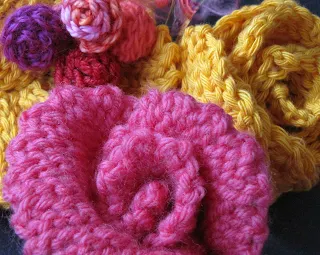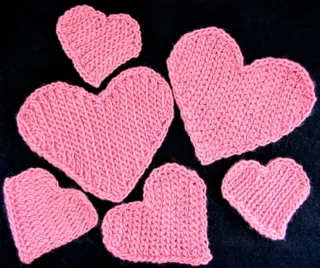 |
| Pin-Setter Cardigan by Dora Ohrenstein (Scroll to the end of this post for the hook size needed and other details.) Photo © 2014 Interweave Press. |
I get to see my yarn brought to life by other designers, and then showcased in magazines!
Dora Ohrenstein chose Lotus yarn for her retro-stripy "Pin-Setter Cardigan." It's in Crochetscene, a new special issue from Interweave Press.
It's a fun chance for me to see the Pearly Pearl, Peachy Sheen, and Sapphire colors together in one sweater.
I still remember when I met Dora: we became friends when we sat next to each other in Lily Chin's Crochet Tips and Tricks class at a CGOA conference. That was in 2004, when we were both new designers.
Ten years later I get to see Dora interpret her design sensibility with my first yarn, so it has special significance for me. I also love how this magazine issue fitted the design and yarn colors in its throwback bowling alley theme - especially the model's beehive hairdo!
 |
| Pearly Pearl, Peachy Sheen, Sapphire |
It's a fun chance for me to see the Pearly Pearl, Peachy Sheen, and Sapphire colors together in one sweater.
I still remember when I met Dora: we became friends when we sat next to each other in Lily Chin's Crochet Tips and Tricks class at a CGOA conference. That was in 2004, when we were both new designers.
Ten years later I get to see Dora interpret her design sensibility with my first yarn, so it has special significance for me. I also love how this magazine issue fitted the design and yarn colors in its throwback bowling alley theme - especially the model's beehive hairdo!
 |
| Dora's original swatch in White Blaze, Teal Glimmer, Grenadine. |
I'm grateful to the editor of Interweave's crochet magazines, Marcy Smith, for her interest in DesigningVashti.com Lotus yarn. Her encouragement means so much for a startup yarn company like me. Doris Chan designed lace boxer shorts and long pants in Lotus yarn for the summer issue of Interweave Crochet magazine. (I have more to post about those later!)
Designers: Anyone is welcome to submit design proposals using Lotus to Marcy. Not just Marcy! Other editors too! I'm not at liberty to give details yet, but I'll let you know when designs in Lotus appear in more magazines, and books...
Can you imagine how immensely relieved I am to learn this? Designs using new yarns by new companies have a chance to be published in magazines.
As a crocheter, I'm glad too. I've been an avid crochet magazine reader (and collector!) for over ten years. I don't remember thinking much about the yarns used in the designs. If asked, I'd want to see a refreshing range of different yarns.
A familiar crochet stitch pattern can look so different sometimes, depending on the yarn, color, dyeing process, fiber content, thickness. Yarns can make the same design look different with a change in drape, stretch, luster.
For a polished summery drape that would also hold up to wear, Lotus is Doris' first choice for skirts and pants. For the lace shorts she used the same Pearly Pearl color that Dora did, and Satin Grey Lotus for the pants.
 |
| Doris used Pearly Pearl for the Gypsy Boxers (Ravelry link) Photo © 2014 Interweave Press. |
Designers: Anyone is welcome to submit design proposals using Lotus to Marcy. Not just Marcy! Other editors too! I'm not at liberty to give details yet, but I'll let you know when designs in Lotus appear in more magazines, and books...
Can you imagine how immensely relieved I am to learn this? Designs using new yarns by new companies have a chance to be published in magazines.
 |
| The Gypsy Pants in Satin Grey Lotus. (Ravelry design page) Photo © 2014 Interweave Press |
 |
| One of my favorite Lotus colors: Satin Grey used for Gypsy Pants! |
For a polished summery drape that would also hold up to wear, Lotus is Doris' first choice for skirts and pants. For the lace shorts she used the same Pearly Pearl color that Dora did, and Satin Grey Lotus for the pants.
-:------------:-
This post is part of a series about what it's like to start my own yarn company, as a crochet designer. Here's the first post, where you can also see a list of the other ones in this series.
About the Pin-Setter Cardigan pattern in Crochetscene:
(For more, click here): A great first sweater project, this classic cardigan is worked top down with raglan sleeves. Stripes in alternating colors keep it interesting, and picots embellish two stripes.
Yarn DesigningVashti Lotus (52% cotton, 48% rayon; 256 yd [234 m]/3½ oz [100 g]): pearly pearl (A), 5 (6, 7, 8, 9) balls; sapphire (B), 2 (2, 2, 3, 3) balls; peachy sheen (C), 1 (1, 1, 2, 2) ball(s).
Hook Size D/3 (3.25 mm).































